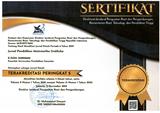PENGARUH FREKUENSI PEMBERIAN TES FORMATIF TERHADAP HASIL BELAJAR MATEMATIKA SISWA KELAS VIII SMP NEGERI 4 SINGARAJA
DOI:
https://doi.org/10.23887/jjpm.v3i1.5984Abstract
Penelitian ini bertujuan untuk mengetahui apakah terdapat perbedaan hasil belajar matematika antara kelompok siswa yang diberikan tes formatif dengan frekuensi tinggi, sedang dan rendah serta untuk mengetahui hasil belajar matematika siswa yang diberikan tes formatif dengan frekuensi yang bagaimanakah dapat memberikan hasil belajar matematika terbaik. Populasi dalam penelitian ini adalah siswa kelas VIII SMP Negeri 4 Singaraja tahun ajaran 2014/2015. Pengambilan sampel dilakukan dengan menggunakan teknik cluster sampling. Desain penelitian yang digunakan dalam penelitian ini adalah Post Test Only Control Group Design. Pada penelitian ini, hasil belajar matematika siswa yang diteliti yaitu pada ranah kognitif yang meliputi tingkatan pengetahuan, penalaran dan penerapan. Data hasil belajar matematika siswa diperoleh dengan menggunakan tes hasil belajar matematika yaitu berupa tes uraian. Skor tes hasil belajar matematika siswa dianalisis dengan menggunakan uji ANAVA satu jalur. Hasil pengujian hipotesis menunjukkan bahwa terdapat perbedaan hasil belajar matematika antara kelompok siswa yang diberikan tes formatif dengan frekuensi tinggi, sedang dan rendah. Kemudian dilanjutkan dengan uji lanjut ANAVA yaitu dengan uji Scheffe ̀. Hasil uji Scheffe ̀ menunjukkan bahwa hasil belajar matematika siswa yang diberikan tes formatif dengan frekuensi tinggi lebih tinggi daripada frekuensi sedang dan hasil belajar matematika siswa yang diberikan tes formatif dengan frekuensi sedang lebih tinggi daripada frekuensi rendah. Jadi, dapat disimpulkan bahwa frekuensi pemberian tes formatif memberikan pengaruh positif terhadap hasil belajar matematika siswa dan hasil belajar matematika siswa yang paling baik adalah kelompok siswa yang diberikan tes formatif dengan frekuensi tinggi.Kata Kunci : Frekuensi, Hasil Belajar Matematika, Tes Formatif
This research is aimed to know whether there are differences in mathematics learning outcomes between the groups of students given formative tests with high frequency, medium and low and to know the result of students' mathematics learning outcomes given formative tests with how frequencies can provide the best mathematics learning outcomes. The population in this research was eight grade students of SMP Negeri 4 Singaraja in academic year 2014/2015. Sampling was done by cluster sampling technique. The research design used in this research is the Post Test Only Control Group Design. In this research, students' mathematics learning outcomes studied were in the cognitive domain that includes the level of knowledge, reasoning and application. The data of mathematics student learning outcomes obtained using math achievement test, formed of essay test given at last. Math achievement test scores of students were analyzed using ANOVA one lane. Hypothesis testing results show that there are differences in mathematics learning outcomes between the groups of students given formative tests with high frequency, medium and low. Then proceed with further test is to test Scheffe ANOVA. Scheffe test results showed that the students' mathematics learning outcomes given formative tests with high frequency higher than the frequency with medium frequency and mathematics student learning outcomes given formative test with medium frequency was higher than the low frequency. Thus, it can be concluded that the frequency of formative tests positive impact on learning outcomes of students' mathematics and the best mathematics student learning outcomes was a group of student given formative tests with high frequency.
keyword : Frequency, Formative Test , Mathematics Learning Outcomes
Published
2015-09-07
Issue
Section
Articles
License

Jurnal Pendidikan Matematika Undiksha is licensed under a Creative Commons Attribution-ShareAlike 4.0 International License.





